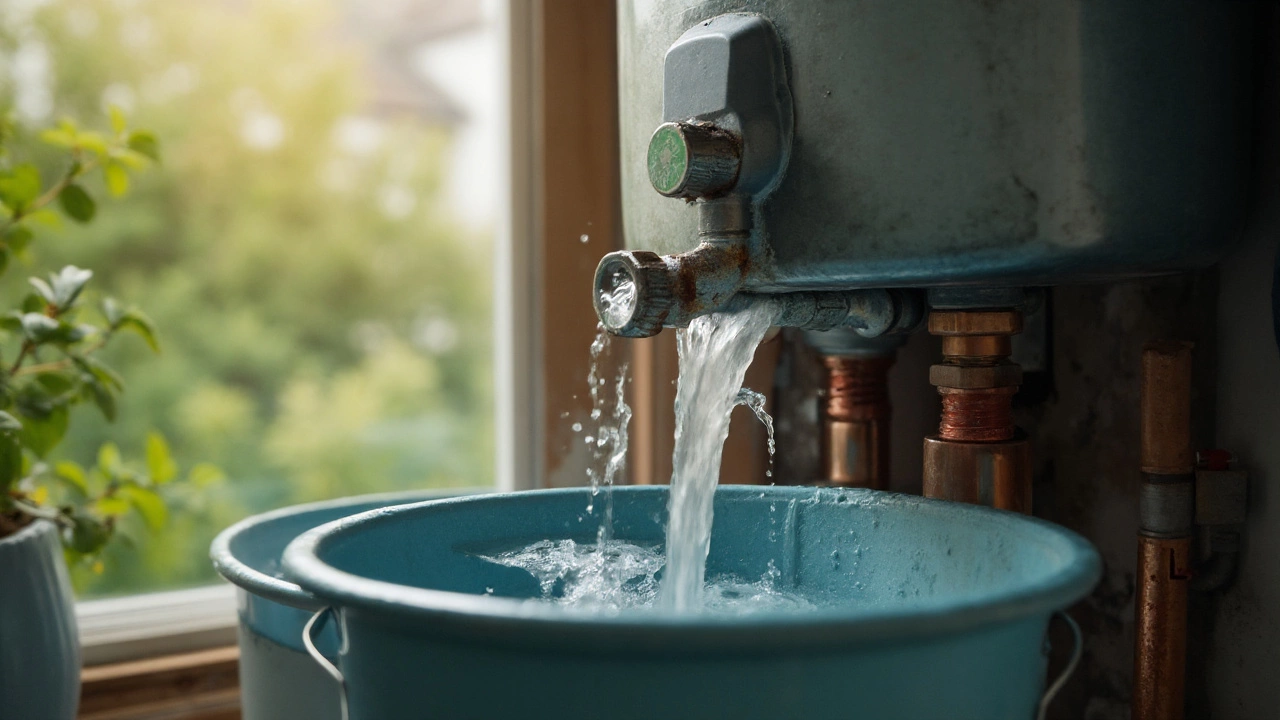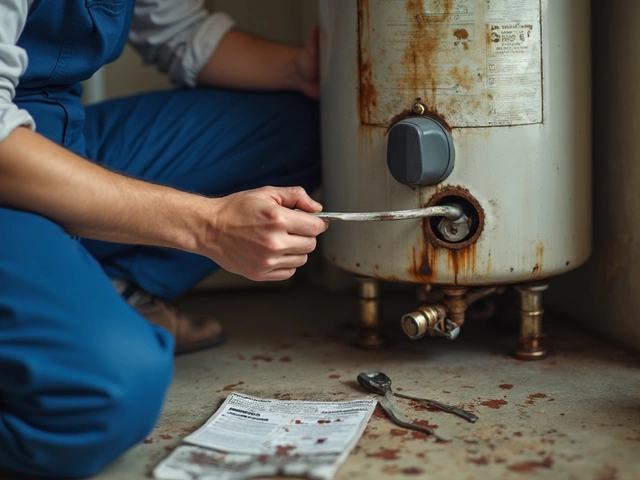Ever thought your hot water smelled off or noticed your morning shower took way longer to heat up? You could be staring at the battle going on inside your water heater—one between sediment and efficiency. The real power move for most homes comes down to a simple question: should you flush your water heater or just drain it? There are more benefits on the line than you might expect, from monthly bills to how long your heater even lives. You'd be surprised how much gunk collects in a tank you've never really opened up.
Why Sediment Buildup Is the Enemy of Your Water Heater
Sediment is the silent killer in water heaters—especially if you live in a region with hard water. Tiny bits of minerals like calcium and magnesium sneak in with your tap water and settle right at the bottom of the tank. Think of your water heater's tank as a pot you never clean after boiling pasta. Over time, all that leftover stuff doesn’t just sit there; it starts throwing off the whole system.
Here’s the deal: when enough sediment builds up, it forms a sort of blanket between the flame (or heating element) and your water. That means your heater has to work extra hard to push the heat through all that mess. The result? Higher energy bills and water that takes way longer to heat—or sometimes just never gets fully hot. Some water heaters start making popping or crackling noises when there’s too much buildup, almost like a kettle on the boil. That sound is actually steam bubbles trying (and failing) to escape through the crust of minerals.
And it’s not just an annoyance. According to a 2022 study by the Water Quality Association, homes with untreated hard water see water heater energy use spike by up to 25% after just two years. That’s a nice chunk added onto your monthly energy bill. Plus, sediment can eat away at the tank’s lining, creating weak spots that turn into leaks—and nobody wants a flooded utility room at breakfast time.
Water heater manufacturers usually mention tank flushing in their manuals, but most people never actually do it. Some folks don’t even know it needs doing! Skipping maintenance might seem fine for the first couple years, but after three to five years, the difference in performance and risk of catastrophic failure starts to add up fast. Ever had to replace a water heater before its 10-year lifespan was up, even though the water looked clear from the tap? Sediment was probably behind it.
It’s worth pointing out that sediment issues aren’t just for old heaters. Even new tanks can start collecting debris in as little as six months. Some areas—like Las Vegas or Phoenix—where the water is practically more mineral than H2O, see faster buildups and more frequent tank problems. If you regularly see white flakes in your bathtub or around faucets, your water heater is definitely collecting sediment even as you read this.

Flush or Drain: What's the Real Difference?
Now, let’s clear up the confusion. People often use "flush" and "drain" interchangeably, but they’re not really the same thing. Draining means you’re simply emptying the water from your heater. Flushing means you’re using water pressure to rinse out all that built-up sediment; you’re not just getting the water out, but the gunk stuck to the bottom too.
Let’s break it down:
- Draining is basically you opening the tank valve and letting gravity do its thing. You’ll get the hot water out, but most of the chunky sediment won’t move unless it happens to be floating right by the drain. It clears the tank but leaves the stuck-on minerals behind. If you’re switching out an old heater or shutting down for the season (like in a vacation home), this is the typical move. It’s fast, simple, but doesn’t fix the core issue.
- Flushing is the gold standard when it comes to maintenance. You open the tank valve with the water still running (or cycle water through the tank as you drain), forcing a stream of water to blast the sediment out. Done right, you see a wave of cloudy, gritty water shooting from the hose until it finally runs clear. It can be messier, takes a bit longer, but actually keeps your tank clean inside. Your heater stays efficient longer, with less noise and less chance of damage. This is what manufacturers mean when they talk about maintenance.
Manufacturers like Rheem or Bradford White usually suggest doing a flush once every year if you have hard water, or every 2-3 years in soft water areas. Draining alone might be enough for vacation homes, but if you rely on hot showers daily, skipping a real flush means you’re letting problems build up inside your tank where you can’t see them.
A lot of myths float around this topic. Some people swear you’re fine just draining. But if you’ve ever looked inside a neglected tank—some plumbers post nightmare photos of tanks packed with almost an inch of caked-on minerals—you’ll see why a drain isn’t enough. The only way to really clear out sediment is to keep water moving as you clean out the heater. A 2018 North American Plumbing Efficiency survey found that regular flushing extends average heater life from 8 to over 12 years. That’s a big difference when you’re staring down the cost of a new tank.
One other benefit: if you flush regularly, your water stays cleaner. That means less odor (especially from bacteria that love sitting in warm, mineral-rich water) and no weird color tinge from rust or gunk that leaks past the dip tube. For those with kids—who love long baths or hot water for endless laundry—this add-on benefit is worth the hassle, and it’s honestly not as tricky to do as it sounds.
| Action | Removes Water | Removes Sediment | Average Time | How Often? |
|---|---|---|---|---|
| Drain | Yes | No (barely) | 10-20 min | As needed, yearly for unused tanks |
| Flush | Yes | Yes | 30-45 min | Yearly (hard water) or every 2-3 years (soft) |
When you look at the energy savings, longer tank life, and fewer breakdown headaches, flushing comes out on top by a mile for families that use their water heater often.

How to Flush Your Water Heater Safely (And What the Pros Wish You Knew)
Flushing your water heater sounds intimidating for a lot of folks, but it’s actually as basic as a DIY project can get. You don’t need special tools—just a cheap garden hose, a bucket, and maybe some gloves if you don’t want to get splashed. Still, there are a few tricks that make it go way smoother, and a couple of rookie mistakes you want to dodge at all costs.
- Step 1: Turn Off the Power
For electric heaters, shut off the breaker. For gas, turn the gas to 'pilot.' Trying to flush a tank with the element on risks burning out the heating element (it can crack if it’s dry!). - Step 2: Shut Off the Cold Water Inlet
This is the pipe that feeds water into the heater, usually marked with a blue handle. This keeps the tank from constantly refilling as you flush. - Step 3: Attach a Hose to the Drain Valve
Drag the other end somewhere safe—outside, a floor drain, or a large bucket. The drained water is hot, so keep kids and pets clear. - Step 4: Open a Hot Water Faucet
Turn on a tap somewhere else in your house (like the kitchen sink). This stops pressure lock and helps the water drain smoothly. - Step 5: Open the Drain Valve
Let the water flow out. If it slows or stops before emptying, open the cold water inlet for a minute—the extra pressure breaks up stubborn sediment. Keep going until the water runs clear and you stop seeing chunks or milky color. - Step 6: Close the Valve and Refill
Shut the drain, close the hot water tap, and turn the cold inlet back on. Only power the heater back up after the tank is full again—you’ll hear it when it stops gurgling.
One insider tip: if you live in an area with super hard water, use a hose nozzle to send a jet of water directly into the drain valve (with the tank mostly empty). This can blast out stubborn crust from the bottom. Just go slow—high pressure can loosen more than you want if your tank is already weakening from years of buildup.
Here’s a common trap: don’t forget the anode rod. It’s a little metal stick inside the tank, designed to attract corrosion so the tank stays safe. Checking or replacing it every 5 years (takes 10 minutes, and you just need a socket wrench) can stretch your tank’s life even longer. Some plumbers call this the "forgotten hero" because almost nobody checks it, but it’s the #1 way to keep rust from eating holes in your water heater.
If your house runs on hard water, consider a water softener. It’s not cheap upfront, but it drops your need for flushing to maybe once every three years. That’s less work, less risk, and years off the calendar before you need a new tank. According to a 2024 customer satisfaction survey by HomeWater Solutions, families using both regular heater flushing and a softener reported the lowest repair costs and longest heater lifespans among all water heater owners polled.
One last word: don’t skip flushing just because you live alone or use little hot water. Small households still see buildup, especially if hot water sits in the tank for days at a time. Even vacation homes can develop thick sediment layers just from periodic use. That’s why so many water heater leaks seem random—they’re not, it’s just years of ignored maintenance boiling over, literally. If you’ve got a tank you care about, a flush each spring can save you from a mountain of stress (and cold morning showers) later.





